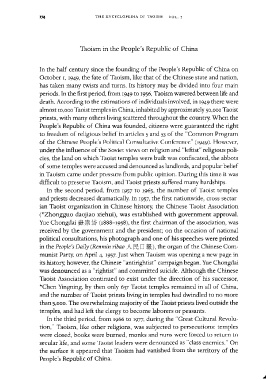Page 214 - The Encyclopedia of Taoism v1_A-L
P. 214
174 THE ENCYCLOPEDIA OF TAOISM VOL. I
Taoism in the People's Republic of China
In the half century since the founding of the People's Republic of China on
October I, 1949, the fate of Taoism, like that of the Chinese state and nation,
has taken many twists and turns. Its history may be divided into four main
periods. In the first period, from 1949 to 1956, Taoism wavered between life and
death. According to the estimations of individuals involved, in 1949 there were
almost IO,OOO Taoist temples in China, inhabited by approximately 50,000 Taoist
priests, with many others living scattered throughout the country. When the
People's Republic of China was founded, citizens were guaranteed the right
to freedom of religious belief in articles 5 and 53 of the "Common Program
of the Chinese People's Political Consultative Conference" (1949). However,
under the influence of the Soviet views on religion and "leftist" religious poli-
cies, the land on which Taoist temples were built was confiscated, the abbots
of some temples were accused and denounced as landlords, and popular belief
in Taoism came under pressure from public opinion. During this time it was
difficult to preserve Taoism, and Taoist priests suffered many hardships.
In the second period, from 1957 to 1965, the number of Taoist temples
and priests decreased dramatically. In 1957, the first nationwide, cross-sectar-
ian Taoist organization in Chinese history, the Chinese Taoist Association
(*Zhongguo daojiao xiehui), was established with government approval.
Yue Chongdai titt*,1j1 (1888-1958), the first chairman of the association, was
received by the government and the president; on the occasion of national
political consultations, his photograph and one of his speeches were printed
in the People's Daily (Renmin ribao A ~ B ¥In the organ of the Chinese Com-
munist Party, on April 4, 1957. Just when Taoism was opening a new page in
its history, however, the Chinese "antirightist" campaign began. Yue Chongdai
was denounced as a "rightist" and committed suicide. Although the Chinese
Taoist Association continued to exist under the direction of his successor,
*Chen Yingning, by then only 637 Taoist temples remained in all of China,
and the number of Taoist priests living in temples had dwindled to no more
than 5,000. The overwhelming majority of the Taoist priests lived outside the
temples, and had left the clergy to become laborers or peasants.
In the third period, from 1966 to 1977, during the "Great Cultural Revolu-
tion," Taoism, like other religions, was subjected to persecutions: temples
were closed, books were burned, monks and nuns were forced to return to
secular life, and some Taoist leaders were denounced as "class enemies." On
the surface it appeared that Taoism had vanished from the territory of the
People's Republic of China.

